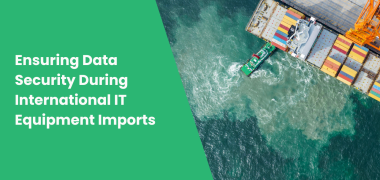In today’s interconnected world, businesses increasingly rely on international supply chains for IT equipment to meet their technological needs. From servers and storage devices to laptops and network components, these imports are vital for ensuring the efficiency and competitiveness of global enterprises. However, the reliance on international IT equipment imports also exposes businesses to data security risks, such as hardware tampering, software vulnerabilities, and unauthorized data access.
This article explores the importance of data security during international IT equipment imports, common threats, best practices for mitigating risks, and the role of technology and regulations in ensuring a secure supply chain.
The Importance of Data Security in IT Equipment Imports
- Safeguarding Sensitive Information
IT equipment often holds or processes sensitive data. A breach during or after import can expose organizations to financial, reputational, and operational risks. - Regulatory Compliance
Governments worldwide impose strict regulations on data security, such as GDPR in Europe and CCPA in California. Non-compliance due to a supply chain breach can result in severe penalties. - Operational Continuity
Compromised IT equipment can lead to downtime, disrupting critical business functions and causing financial losses. - Trust and Reputation
Businesses that fail to secure their IT imports risk losing customer trust and tarnishing their reputation, especially if a breach leads to data leaks.
Common Data Security Risks in IT Equipment Imports
- Hardware Tampering
During transit, IT hardware can be intercepted and tampered with to introduce malicious components, such as spyware or backdoors, that compromise data integrity and confidentiality. - Software Vulnerabilities
Imported IT equipment may come preloaded with outdated or vulnerable software, exposing organizations to cyberattacks. - Counterfeit Products
Counterfeit IT equipment may lack robust security features, making them susceptible to exploitation by cybercriminals. - Lack of Secure Packaging
Insecure packaging increases the risk of interception during transportation, allowing attackers to gain physical access to hardware. - Insider Threats
Employees within the supply chain, whether at the supplier’s facility, customs, or shipping, may exploit access to tamper with equipment. - Unsecured Disposal of Old Equipment
Organizations that fail to securely dispose of replaced equipment risk exposing sensitive data.
Best Practices for Securing IT Equipment Imports
To mitigate risks, organizations must adopt a proactive approach to data security, integrating best practices into every stage of the import process:
1. Vet Suppliers Thoroughly
- Reputation Checks: Partner with suppliers known for stringent security standards and compliance with global regulations.
- Certifications: Ensure suppliers have certifications such as ISO/IEC 27001 for information security management systems.
- Audits: Conduct regular audits of supplier facilities to verify adherence to security protocols.
2. Use Secure Shipping Channels
- Partner with logistics providers experienced in handling sensitive IT equipment.
- Opt for tamper-proof packaging and use tamper-evident seals to detect unauthorized access.
- Monitor shipments with GPS tracking to ensure the integrity of transit routes.
3. Implement Supply Chain Transparency
- Blockchain Technology: Use blockchain to track and document every stage of the supply chain, ensuring transparency and reducing the risk of tampering.
- Digital Twins: Create virtual replicas of the supply chain to simulate and address potential vulnerabilities.
4. Test Equipment Before Deployment
- Conduct rigorous testing for hardware integrity and software authenticity upon arrival.
- Use tools to scan for malicious firmware or hidden components in hardware.
5. Encrypt Sensitive Data
- If data must be preloaded onto equipment before shipment, ensure it is encrypted using robust standards such as AES-256.
- Use hardware security modules (HSMs) to manage encryption keys securely.
6. Implement Endpoint Protection
- Install endpoint protection software on imported devices to safeguard against potential threats.
- Regularly update software and firmware to address vulnerabilities.
7. Dispose of Replaced Equipment Securely
- Use certified IT asset disposal (ITAD) providers to wipe or destroy data on decommissioned equipment.
- Adhere to environmental regulations while disposing of hardware.
Role of Technology in Enhancing Data Security
Technological advancements play a crucial role in mitigating data security risks during IT equipment imports. Here’s how:
- Blockchain for Supply Chain Security
Blockchain creates an immutable record of every transaction and movement in the supply chain, preventing unauthorized alterations and providing end-to-end traceability. - IoT-Enabled Tracking Devices
IoT sensors attached to shipments monitor real-time data, such as location, temperature, and tamper status, alerting stakeholders to anomalies. - Artificial Intelligence (AI)
AI-driven analytics identify unusual patterns in supply chain activities, such as deviations in shipping routes, signaling potential security breaches. - Secure Boot Technology
Devices equipped with secure boot ensure that only verified software is executed, protecting against tampering at the firmware level. - Zero Trust Architecture
Zero Trust principles ensure that imported devices are not trusted by default. All access to sensitive systems is continuously verified and monitored.
Regulatory Frameworks for Secure IT Imports
Governments and international organizations have established regulations to address data security concerns in global supply chains. Key frameworks include:
- Customs-Trade Partnership Against Terrorism (C-TPAT)
A U.S. initiative that enhances supply chain security, requiring companies to assess and mitigate risks associated with international trade. - General Data Protection Regulation (GDPR)
While primarily focused on data privacy, GDPR emphasizes the need for secure IT systems to protect personal data. - NIST Cybersecurity Framework
Developed by the U.S. National Institute of Standards and Technology, this framework provides guidelines for managing and reducing cybersecurity risks. - ISO/IEC 20243:2018 (Open Trusted Technology Provider Standard)
This standard outlines best practices for mitigating maliciously tainted or counterfeit products in the global supply chain. - Secure Equipment Act
U.S. legislation that restricts the import of IT equipment from manufacturers associated with security threats, such as espionage.
Case Studies: Data Security in IT Equipment Imports
Case Study 1: Huawei Ban in the United States
Concerns over potential backdoors in Huawei’s networking equipment led to restrictions on its import into the U.S. This case underscores the importance of vetting suppliers for data security risks.
Case Study 2: Supermicro Supply Chain Attack
Reports in 2018 alleged that microchips inserted during manufacturing in China compromised Supermicro’s hardware. Though disputed, the incident highlights the need for stringent hardware integrity checks.
Case Study 3: Microsoft’s Secure Supply Chain Initiative
Microsoft employs blockchain technology and AI to secure its supply chain, ensuring that devices and components meet rigorous security standards.
Future Trends in Data Security for IT Equipment Imports
As the threat landscape evolves, the future of secure IT imports will be shaped by:
- Quantum Cryptography
Quantum computing promises to revolutionize encryption, offering virtually unbreakable security for sensitive data. - Edge Computing for Supply Chain Security
Decentralized edge devices will enable real-time data processing and threat detection within the supply chain. - Collaborative Cybersecurity Initiatives
Governments and businesses will increasingly collaborate to establish shared cybersecurity standards and protocols. - AI-Powered Threat Mitigation
Advanced AI algorithms will predict and neutralize threats before they materialize, ensuring uninterrupted supply chain operations.
Conclusion
In the digital age, ensuring data security during international IT equipment imports is a critical priority for businesses. With the right strategies, technologies, and regulatory compliance, organizations can mitigate risks, safeguard sensitive information, and maintain trust in their supply chains. While the challenges are significant, the rewards of a secure supply chain—enhanced efficiency, compliance, and reputation—make the investment worthwhile.
By embracing proactive measures and staying ahead of emerging threats, businesses can not only protect their data but also drive innovation and growth in the global marketplace




